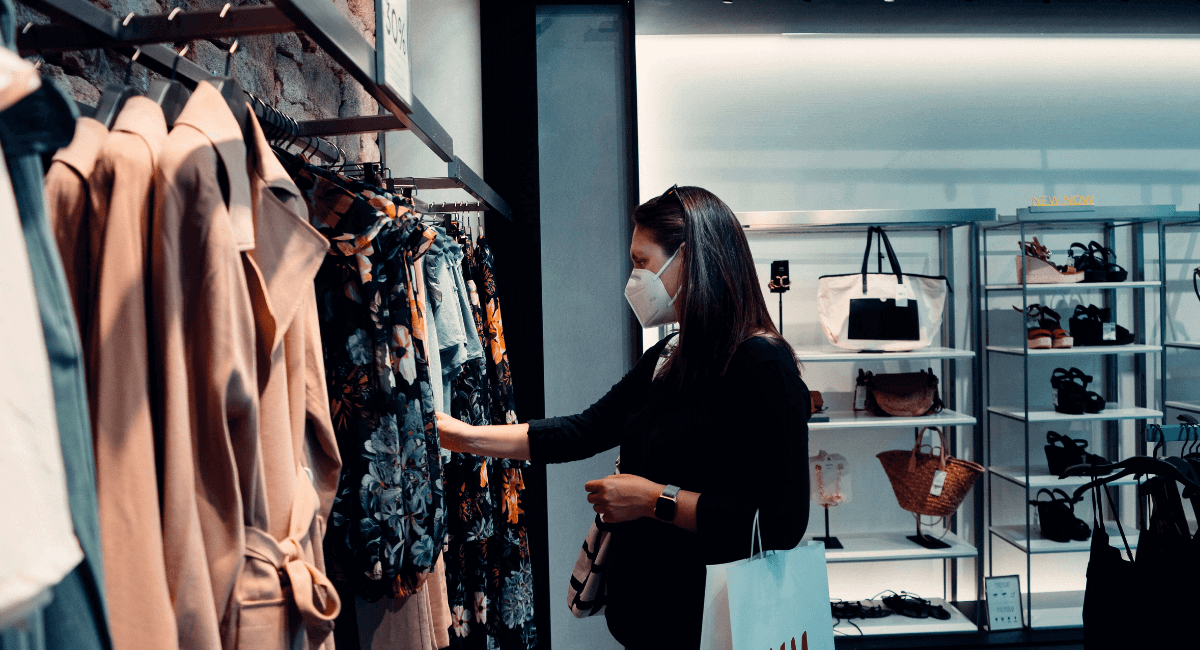
20 Scary Shopping Addiction Statistics You Need to Know in 2024
Posted on | by Milos Djordjevic
Many people have certain addictions they try to control, but they always find new ways to get serotonin floating in their bodies. Well, shopping makes our body full of happy hormones, and some even say that it is better than therapy.
That said, we prepared some fascinating shopping addiction statistics that will show you how much shopping can influence people and their everyday choices. Now let’s dive into some numbers.
Most Interesting Shopping Addiction Statistics (Editor’s Pick)
- In 2022, the global online shopping market size will reach $5.5 trillion.
- Oniomania, or compulsive buying disorder (CBD), affects 8–16% of the UK population.
- Women are nine times more likely to buy compulsively than men.
- Around 96% of people admit they are making impulsive purchases either in stores or online.
- There is a clear neurobiological link between compulsive buying and substance misuse.
- About 43.5% of Americans regret buying things on sale.
- Around 3% of European adults may display a level of shopping addiction.
- The number of people who shop online reached 2.14 billion in 2021.
Top Shopping Addiction Stats
1. More than 37% of UK shoppers have felt guilt or shame after shopping.
(UK Rehab)
Shopping addiction stats show that more than 37% of people with shopping addiction have felt guilt after making an impulsive purchase. Moreover, 20% of buyers have hidden things they bought from the members of their family.
2. Oniomania, or compulsive buying disorder (CBD), affects 8–16% of the UK population.
(Priory)
People with CBD claim that they are preoccupied with shopping, feel pre-purchase tension or anxiety and believe that shopping will relieve the discomfort. Shopping addiction or oniomania can ruin your life. In the UK, compulsive shopping statistics show that this mental disorder affects 8–16% of the population, and the majority of affected subjects are women.
3. The average age of a person with a shopping addiction in the UK is 30.
(UK Rehab)
Compulsive buying disorder is pretty common. People with this type of disorder can be obsessed with a particular class of items, such as clothes, jewellery, beauty products, or technology. Shopping addiction statistics in the UK show that the average age of a person with a shopping addiction problem is 30.
4. Around 85% of people suffering from a shopping addiction develop ‘worrying’ debt levels.
(UK Rehab)
As a result of their overspending habits, many people may end up in financial trouble. One of the most evident outcomes of shopping addiction is long-term debt problems. Many compulsive buyers will accumulate debt worth thousands of dollars.
According to statistics on shopping addiction, nearly 85% of shopping addicted people in the United Kingdom have debt problems.
5. Women are nine times more likely to buy compulsively than men.
(Verywell Mind)
Compulsive buying statistics reveal that women are nine times more likely to buy compulsively than men. Women are prone to purchase clothes, purses, shoes, perfumes, makeup, and jewellery, while men prefer electronics, suits, cars, and watches.

6. Almost 33% of compulsive shoppers receive criticism from friends and family about their shopping habits.
(The Recovery Village)
Even if their friends or family share their love of shopping, one of the lesser-known shopping addiction facts is that people with a shopping addiction usually shop alone. According to shopping addiction statistics, almost 33% of shoppers receive criticism from their friends and family about their shopping habits.
7. Around 96% of people admit they are making impulsive purchases either in stores or online.
(Finder)
Online shopping addiction research shows that approximately 64% of people shop impulsively on the Internet, while 77% do that in land-based stores. On average, people admit that they spend $81.75 on impulsive online purchases, while they spend $85.85 in stores.
On the other hand, more than 52% of compulsive shoppers buy items because they don’t want to miss out on a deal, and 6% feel pressured by friends or online promotions.
8. There is a clear neurobiological link between compulsive buying and substance misuse.
(Cambridge)
Research on shopping addiction shows that compulsive buyers often have some other disorders as well. For example, 46% of them misuse substances, 68% have some affective disorders, and 41% have an anxiety disorder. On the other hand, 15% of compulsive buyers have an eating disorder.
9. More than 24% of shoppers in the UK own items they have bought but never used.
(UK Rehab)
Nowadays, we pay for many things we will probably never use or don’t need at all. Shopping statistics in the UK show that more than 24% of people have bought something but never used it. Moreover, for some people, shopping is therapy. That said, around 10% of people in the UK shop only to feel better.
10. Compulsive hoarding is often a result of compulsive shopping.
(Arise Network)
Both compulsive shoppers and compulsive hoarders associate material goods with a sense of happiness and fulfilment. They usually shop when feeling emotionally distressed as shopping makes them feel good.
Compulsive shopping often leads to compulsive hoarding since a person is unable to part with the objects they bought, although these objects are of no use to them. They even collect items such as boxes, plastic bags and receipts.
This disorder is so strong that a person is unable to stop collecting objects even if they face specific problems like separation from loved ones, unhealthy living conditions or legal troubles.
11. A lot of impulsive shopping decisions are made after midnight.
(My Broken Coin)
After a night of drinking and celebrating, some people like to turn on their computer and do a bit of ‘window shopping’. However, this can lead to wrong decisions, like buying items you don’t need or overspending. So, if you are willing to sacrifice good night sleep just to window shop online, maybe it is a sign that you are a shopaholic.

Shopping Addiction Around the World
12. Around 3% of European adults may display a level of shopping addiction.
(UK Rehab)
According to shopping addiction statistics, around 3% of European adults and 8% of European young people may display some level of shopping addiction. In contrast, the US population levels that may be afflicted by shopping addiction range between 2% and 12%.
13. The average American woman spends 190 hours every year shopping for clothes, shoes or doing window shopping.
(Forbes)
Shopping addictions statistics show that the average American woman spends 190 hours every year shopping for clothes, shoes, or window shopping. Every year, women spend more than 100 hours on 30 clothes-shopping trips, 40 hours on 15 shoe-shopping trips, and 50 hours on window shopping.
Moreover, these women spend 95 hours and 84 trips shopping for food.
14. About 43.5% of Americans regret buying things on sale.
(Finder)
A survey shows that 65.1% of people bought things they didn’t need just because they were on sale. Moreover, those who regretted a discounted purchase had spent an average of $431 on it.
Shopping addicts demographics show that women spent approximately $343 on discounted purchases, while men spent around $526. Similarly, Generation X gave approximately $585 for discounted goods, while boomers spent $413 and millennials invested $236.
15. Black Friday is a shopping event with the largest number of disasters.
(Beliefnet)
Black Friday is the busiest shopping day of the year, characterised by great sales and excited buyers. However, this is also a day marked by injuries and even deaths that are a result of mass hysteria.
The 2008 Black Friday in New York was marked by an unfortunate event when a Wal-Mart’s worker was trampled to death by a stampede of over 2000 people. In another Wal-Mart incident from 2011, the crowd of shoppers knocked down a teenager and stepped on her. Fortunately, she wasn’t seriously injured.
Apart from trampling, Black Friday was also marked by shooting. In 2008, two Toys-R-Us’s customers brandished their guns during their wives’ heated conversation and shot each other. Both of them succumbed to injuries.

Interesting Online Shopping Statistics
16. Ecommerce in the United Kingdom reached €222 billion in 2020.
(Ecommerce News)
Ecommerce statistics show that the market has grown during the last decade and will keep growing in the next few years. Ecommerce in the United Kingdom was worth €222.5 billion, which was more than 11% compared to the previous year, when the ecommerce turnover was worth around €200 billion.
17. Around 87% of people in the United Kingdom made online purchases in 2020.
(Statista)
People in the UK keep browsing online shops and websites to find the best prices and deals. According to shopaholic statistics in the UK, around 82% of people made online purchases in 2019, while in 2020, that number is about 87%.
18. The number of people who shop online reached 2.14 billion in 2021.
(Statista)
The number of people who shop online reached 2.14 billion in 2021, which is about 27.08% of the global population. However, the number of online shoppers increases along with the growth of people with internet connections.
19. About 62% of online buyers shop at least once per month.
(Oberlo)
Nowadays, online shopping is becoming more and more attractive. Online shopping addiction statistics show that around 62% of digital buyers shop at least once a month. Furthermore, 26% of online shoppers shop once a week, and 3% shop once a day.
But not everyone can handle online shopping. More than 46% of online customers have failed to complete an online purchase because there was a significant number of options to choose from.
20. In 2022, the global online shopping market size will reach $5.5 trillion.
(Statista)
The USA alone is predicted to have 300 million online shoppers in 2023, which makes up 91% of the entire population. Thus far, 69% of Americans have shopped online, and 25% of American people shop online at least once a month. Moreover, 59% of these shoppers bought clothes, and 47% bought their first item on Amazon.

Conclusion
Shopping addiction is like every other addiction; it can bring people happiness and fulfilment, as well as the feeling of shame. It can lead to overspending, compulsive shopping and hoarding items they don’t need.
Hopefully, these shopping addiction statistics can shed some light on shopping addiction problems and help you understand the struggles shopping addicts face every day and potentially help someone coping with a shopping addiction.
FAQ
How do I stop being addicted to shopping?
If you’re wondering how to overcome shopping addiction, you’ve already made the first important step. After this, you should find alternative ways of enjoying your free time. Moreover, it is essential to cancel all your credit cards and keep only a small amount of cash with you so that you can avoid impulse buying. It is also a good idea to go shopping only with friends who are not prone to compulsive buying and can help you restrain yourself from overspending.
Is compulsive shopping an addiction?
Compulsive shopping is a mental disorder that can cause serious consequences. Moreover, compulsive buying is connected to various other mental illnesses, such as anxiety, depression, and other mood and eating disorders. People with shopping disorders often cannot stop thinking about going out to shop and quickly get themselves and their families into debt problems.
What are the effects of being a shopaholic?
Shopaholic statistics prove that people addicted to shopping, except for emotional instability or mood changes, also suffer from depression, anxiety, and insomnia. However, the compulsive buying effects lead to high levels of stress, resulting in other issues such as physical tics and muscle spasms, together with high blood pressure and consequent health conditions.
What causes compulsive buying?
The causes of compulsive shopping are the same as with other addictions. They can include emotional issues, loneliness, seeking excitement, approval, or the feeling of being in control, and escaping unpleasant feelings.
How many people are affected by compulsive shopping?
Shopping is an activity that almost everyone finds somewhat enjoyable. Still, when shopping becomes a compulsive behaviour that causes problems with your family, partner, and work, it may be a sign that it turned into an addiction.
Shopping addiction statistics show that shopping addiction or oniomania, also known as a compulsive buying disorder, affects about 18 million adults. In the UK, compulsive buying disorder affects around 8–16% of the entire population.
How do I know if I have a shopping addiction?
First of all, shopping addicts may have many unpacked items in their closets and often purchase things they don’t need at all. Secondly, they feel an adrenaline rush whenever they buy an item. Thirdly, they feel anxious and are prone to overspending. Lastly, shopping addicts often feel shame or guilt after making an impulsive purchase.